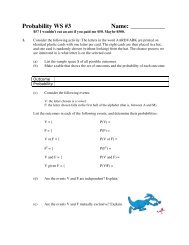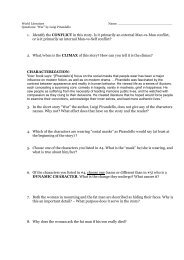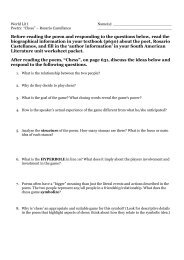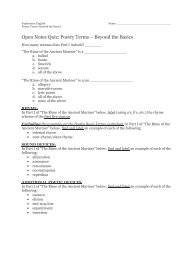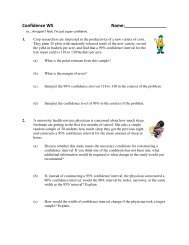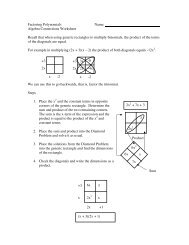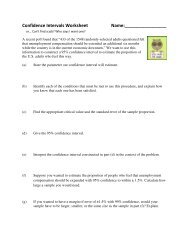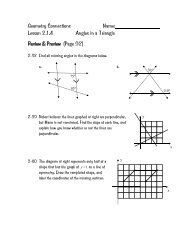Sampling Distributions WS #1 Name: 1. For each description below ...
Sampling Distributions WS #1 Name: 1. For each description below ...
Sampling Distributions WS #1 Name: 1. For each description below ...
You also want an ePaper? Increase the reach of your titles
YUMPU automatically turns print PDFs into web optimized ePapers that Google loves.
<strong>Sampling</strong> <strong>Distributions</strong> <strong>WS</strong> <strong>#1</strong><br />
<strong>Name</strong>: ______________________<br />
Fact: In the 1988 Iowa presidential primary, Mickey Mouse came in second place with 7% of the vote behind Tom Harkin.<br />
<strong>1.</strong> <strong>For</strong> <strong>each</strong> <strong>description</strong> <strong>below</strong>, identify <strong>each</strong> underlined number as a<br />
parameter or statistic. Use appropriate notation to describe <strong>each</strong><br />
number, for example pˆ = 0.96.<br />
(a)<br />
A 1993 survey conducted by the Richmond Times-Dispatch one<br />
week before election day asked voters which candidate for the state’s attorney<br />
general they would vote for. 37% of the respondents said they would vote for the<br />
Democratic candidate. On election day, 41% actually voted for the Democratic<br />
candidate.<br />
(b)<br />
The National Center for Health Statistics reports that the mean systolic blood<br />
pressure for males 35 to 44 years of age is 128 and the standard deviation is 15.<br />
The medical director of a large company looks at the medical records of 72<br />
executives in this age group and finds that the mean systolic blood pressure for<br />
these executives is 126.07.<br />
2. Suppose two different statistics—call them Statistic A and Statistic B—can be used to<br />
estimate the same population parameter. Statistics A has lower bias than B, but A also<br />
has high variability compared to B. On the two axes <strong>below</strong>, draw two parallel dotplots<br />
showing 8 values of <strong>each</strong> statistic that are consistent with these characteristics. Assume<br />
that the parameter value is at the arrow on the axes.<br />
Statistic A<br />
Statistic B
3. A large pet store that specializes in tropical fish has several thousand<br />
guppies. The store claims that the guppies have a mean length of 5 cm<br />
and a standard deviation of 0.5 cm. You come to the store and buy 10<br />
randomly-selected guppies and find that the mean length of your 10<br />
guppies is 4.8 cm. This makes you suspect that the mean fish length is<br />
not what the store says it is. To explore this further, you assume that the length of guppies<br />
is Normally distributed and use a computer to simulate 200 samples of 10 guppies from<br />
the store’s claimed population. Below is a dotplot of the means from these 200 samples.<br />
(a)<br />
What is the population in this situation, and what population parameters have we<br />
been given?<br />
(b)<br />
The distribution of one sample is described in the opening paragraph. What<br />
information have we been given about this sample?<br />
(c)<br />
Is the dotplot above a sampling distribution? Explain.<br />
(d)<br />
Do you think the store is being honest about the length of its guppies? Justify your<br />
answer.



